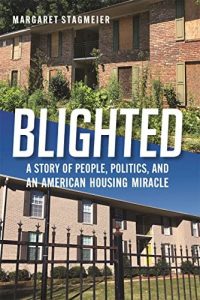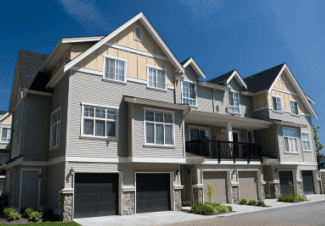Apartment Housing, Public Schools and Health
By Margaret Stagmeier, Author of Blighted: A Story of People, Politics and An American Housing Miracle

I’ve spent my career operating affordable rental apartment communities in low-income neighborhoods in Georgia in a “for profit” model. The investments I seek are large older apartment communities, typically boarded up and with high criminal activity in neighborhoods that investors prefer to avoid. Renovating these legacy apartment communities is my specialty and through my career of owning and managing over 3,000 apartment units, I have come to understand and respect the profound inter-relationship between housing and education on human health. Housing issues like mold proliferation or roach infestations due to poor housekeeping practices, often triggers a sequence of “life-changing” events with unfortunate societal and human consequences. Many of the tenants who live in substandard housing, often have higher incarceration rates, stunted brain development, low reading scores, high student drop-out, homelessness and even early death. Unhealthy blighted housing over time manifests itself in human physiology-creating unhealthy people. Educators and health care workers well understand the consequences of apartment communities in their classrooms and emergency rooms, but very few landlords understand this inter-relationship much less attempt to create solutions.
My journey started after my partners and I purchased Madison Hills Apartments, a 446-unit severely blighted apartment community in north Atlanta. The property was in Cobb County, a wealthy municipality boasting strong management and a triple AAA+ credit score. The Cobb government had little tolerance for a large, 446-unit apartment property with 200+ units uninhabitable due to black mold and fire damage, a high violent crime rate, and a low-performing elementary school. They understood the economic impact of Madison Hills measured by extensive municipal resources expended to address the community turmoil including high police presence, fire response, and extensive court, school, and jail costs which far exceeded the property taxes that Madison Hills contributed to the municipal coffers. In summary, Cobb wanted Madison Hills torn down.
Immediately after our purchase, Cobb took steps to condemn the property. When I questioned their motivation to tear down 446 apartment homes and toss them in the local garbage dump, the answer was simple and direct – the property was in turmoil which caused Brumby Elementary, the local elementary school to fail. After learning their issue, the very next day I visited the Assistant Principal of Brumby and learned words like “transiency” and “mobility”, words very familiar to educators but unknown to many landlords. Transiency is the movement of children during the school year and children that often move between schools typically struggle academically. The evidence-based science backs this with numerous studies documenting a learning loss of three months every time a child moves schools. Landlords can exacerbate student transiency by simply raising rents, operating unhealthy units or reducing security measures creating a domino effect ultimately landing in classrooms and emergency rooms. Apartment housing transiency- initiated by landlords, causes families to move reducing their academic success of their children and burdening the school. The students protectory was further exacerbated by the health impact of substandard housing including roaches and mold (asthma), toxic stress (violent criminal activity), and asbestos (breathing issues). After the meeting with Brumby Elementary, we started a free on-site after school program to stabilize the children, which grew to 60 children by the end of the second year. We also hired off-duty Cobb police officers to provide security and kept our rents affordable for families earning $25-$45,000 year.
It took almost four years of persistent work with Cobb to receive the permits to renovate Madison Hills and in the interim, I learned the impact of housing on education, healthcare, municipalities and people. Everyone with resources stayed in their respective lanes perpetuating the blighted structural elements cascading into an education crisis, healthcare issues and inter-generational poverty. Educators focus on education, landlords focus on housing, municipalities focus on public services, hospitals focus on healthcare and capital focus on returns. Rarely do these resources cross-collaborate to create healthy communities and healthy people. However, Madison Hills demonstrated that landlords of large rental communities have the influence to cross-collaborate resources in a manner that offers affordable, stable housing and improved educational and healthcare outcomes for families. Madison Hills was my “AH HA” moment, and after five years, all sixty children in our after-school program passed the federal competency test, elevating Brumby Elementary to a Title 1 school of distinction.
In 2018, my partners and I purchased Summerdale Apartments, a 244-unit apartment community in southeast Atlanta in a low-income neighborhood. Summerdale was another partially boarded-up blighted apartment community with everything wrong. It had significant violent criminal activity, sixty-eight children living on site – many with low-reading scores, a high incidence of asthma, high population transiency, a low-performing elementary school and traumatized families. I started interviewing the societal ecosystem including the tenant-families living at the property, the local Principal, police lieutenant, property manager, vendors, construction workers, municipal workers, and others involved in the community during the renovation. During these many conversations, I was able to observe the trauma and health consequences of a blighted apartment community. Not surprisingly, the local elementary school was failing and the families were dealing with innumerable health issues. The experience confirmed my perspective on the critical importance of housing on education and human health. Today, Summerdale is 100% renovated and offers rents affordable for families earning $35,000-$45,000. The environment is safer and the children enjoy access to affordable healthcare services, a free after-school program and summer camp, which has increased reading and math test scores. We also partnered with Star-C, a 501c3 that offers residential wrap-around services, and Morehouse School of Medicine to offer families access to primary care medical care. Summerdale proved the model could be replicated in large apartment communities in low-income neighborhoods.
It is well documented that large institutional investors are snapping-up single-family rental and multifamily rental housing en masse and increasing rents at an alarming rate – well beyond inflation. A $200-$500 monthly rental increase is now common place as commodity investors compete for properties, raising rental pricing and singularly focus on their double-digit bottom line. The burden of these large rent increases creates a domino effect – displacing families who relocate in search of affordable housing and consequently, move their children from their school – creating an educational and healthcare crisis. Despite billion-dollar budgets, educators have no control of or solution for mobility.
As a result of the growing commoditization of housing, the education and healthcare crisis initiated by affordable housing shortages will continue to fester and worsen. Housing affordability matters in neighborhood stabilization and neighborhood stabilization matters in healthcare and education. The critical narrative on apartment housing often excludes the downstream impact and intergenerational fault lines intrinsic to stable housing. The solution is affordable housing designed to stabilize neighborhoods, creating a triple win of anchored families, thriving schools, and healthier families. Apartment landlords who embrace the social benefit of this symbiotic relationship recognize that until housing is addressed, education and healthcare will continue to fester, creating the next generation of poverty.
About the Author

















 Accessibility
Accessibility